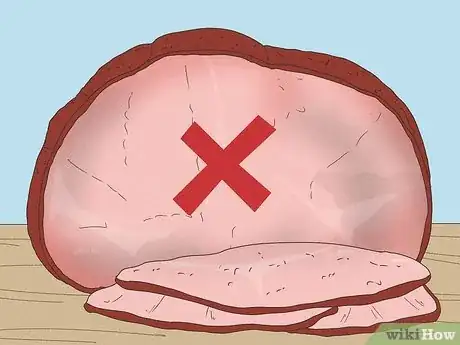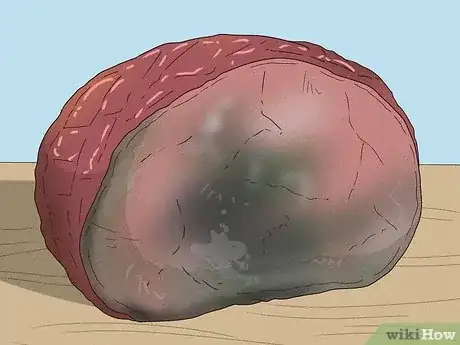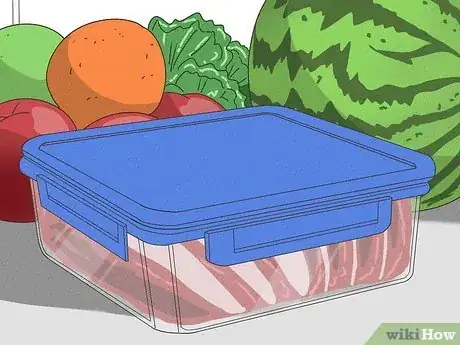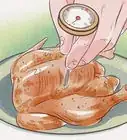This article was co-authored by Marrow Private Chefs and by wikiHow staff writer, Eric McClure. Marrow Private Chefs are based in Santa Rosa Beach, Florida. It is a chefs’ collaborative comprised of an ever-growing number of chefs and culinary professionals. Though regionally influenced primarily by coastal, traditional southern, cajun, and creole styles and flavors, the chefs at Marrow have a solid background in all types of cuisine with over 75 years of combined cooking experience.
This article has been viewed 18,733 times.
Trying to figure out if your ham has spoiled or simply lost a little bit of freshness? Identifying bad ham is easy, and we’ll show you how to do it. In this article, we’ll break down the signs ham has gone bad, examine its shelf life, and help you out in the future with some best practices for storage.
Things You Should Know
- Ham is bad if it smells off, develops discoloration, or begins to feel sweaty or slimy.
- Store ham in the fridge by wrapping it in foil, butcher paper, or plastic wrap. Alternatively, you can use an airtight container or freezer bag and set it in the fridge.
- Ham will typically last 3-5 days in the refrigerator or 1-2 months in the freezer.
Steps
Signs Ham Has Gone Bad
-
1A sour or rancid smell Ham should smell enticing—fresh, salty, and smokey. If your ham smells like sulfur, gasoline, or skunk, throw it out. The sniff test is usually a pretty solid test to determine if ham has gone bad.[1] X Research source
-
2Green or gray discoloration Fresh ham is a shade of pink and the fat is white (if there’s a glaze it’ll be darker shade or brown). When ham starts to go bad, it will typically turn gray, green, or even blue.[2] X Research source
- You may want to cut off the discolored parts use the rest, but none of the ham will be safe to consume if some of it has changed color.[3] X Trustworthy Source Cleveland Clinic Educational website from one of the world's leading hospitals Go to source
Advertisement -
3A slimy or sticky texture Ham should have a soft and moist texture, but it won’t leave any wet or greasy residue behind on your skin. Slimy ham is a sign of bacterial growth, so don’t consume it if it’s wet or oily. Some bacteria may cause ham to become sticky, too. In any case, avoid ham that doesn’t feel right in your hand.[4] X Research source
- This will be especially notable on sliced ham. If you’ve got a whole ham with a crust or glaze, you may not notice this as easily.
-
4Mold Black, brown, white, or green fuzzy material is mold, and if this stuff appears on your ham it’s time to throw it out. Ham should be totally uniform in color and texture.[5] X Research source
- You may be tempted just to cut off mold, but the fact that the mold appeared at all is a sign that the ham isn’t edible anymore.[6] X Trustworthy Source Cleveland Clinic Educational website from one of the world's leading hospitals Go to source
-
5The expiration date has passed Those “use by” dates aren’t arbitrary. If you’ve bought packaged ham that has an expiration date on it and that date passes, do not tempt fate by eating the ham anyway.[7] X Trustworthy Source FoodSafety.gov Online portal combining food safety information from the U.S. Food and Drug Administration, the Food Safety and Inspection Service, and the Centers for Disease Control and Prevention Go to source
How to Store Ham
-
1Wrap sliced ham tightly with plastic or foil and set it in the fridge. Spread the plastic wrap, paper, or foil out on the counter, set your ham in the center, and tightly fold the wrap, paper, or foil over the ham in overlapping layers. Set the ham directly in the refrigerator.[8] X Research source
-
2Set thicker cuts in a freezer bag or airtight container in the refrigerator. If you’ve got a bigger piece of ham, grab an airtight freezer bag or an airtight container and place the ham inside. This will help the ham retain its moisture and keep it from going bad. Set the container or bag inside the fridge.[9] X Research source
- Cut the ham into smaller pieces if your bags or containers aren’t big enough.
How long is ham good for?
-
Most ham lasts 3-5 days in the fridge. Fresh uncooked ham, cooked store-bought ham, and uncured cooked ham will all last under a week in the fridge. This covers deli cuts, uncooked cutlets, sandwich meat, country ham, and honey-glazed ham. After 5 days, discard your ham as it will have gone bad.[10] X Trustworthy Source FoodSafety.gov Online portal combining food safety information from the U.S. Food and Drug Administration, the Food Safety and Inspection Service, and the Centers for Disease Control and Prevention Go to source
- A whole ham will tend to last around 1 week in the fridge.
- Prosciutto, dry Italian ham, Spanish ham, and Serrano ham can last 2-3 months in the fridge.
- Canned ham will last up to 6 months to 2 years if it isn’t opened. Once open, you’ve got the typical 3-5 days.
Can you freeze ham?
-
1Yes, and frozen ham will typically last 1-2 months. If the ham is unopened, just set the container in the freezer. If the ham has been opened, wrap it tightly in plastic wrap or aluminum foil. Then, set the wrapped ham inside a freezer bag. Push the air out of the bag then seal it and set it in the freezer.[11] X Research source
- There are two exceptions to the 1- to 2-month rule. Fresh, uncured, and uncooked ham will last up to 6 months, while fresh, uncured, and cooked ham will last 3-4 months.
- Thaw frozen ham in the refrigerator before using it.
-
2Vacuum-sealed ham will last 3-4 months in the freezer. Instead of leaving the ham wrapped up in a freezer bag, try sealing it in plastic if you have a vacuum sealer! Set the ham inside a clean vacuum-sealing bag. Then, set the bag in the sealer and remove the air. Place it inside of your freezer and enjoy it within the next 4 months.[12] X Research source
You Might Also Like


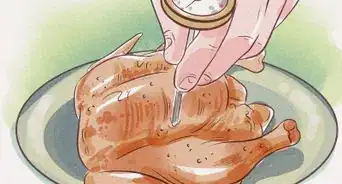
 How to Check if Your Bacon is Spoiled (And How to Keep it Fresh)
How to Check if Your Bacon is Spoiled (And How to Keep it Fresh)
-Step-11.webp) How to Keep Flour Weevils Out of Your Pantry
How to Keep Flour Weevils Out of Your Pantry

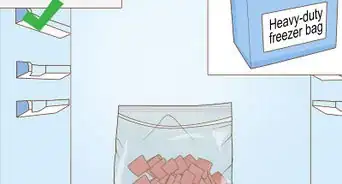


References
- ↑ https://homecookworld.com/is-slimy-ham-still-good/
- ↑ https://homecookworld.com/is-slimy-ham-still-good/
- ↑ https://health.clevelandclinic.org/what-happens-if-you-eat-moldy-food/
- ↑ https://homecookworld.com/is-slimy-ham-still-good/
- ↑ https://homecookworld.com/is-slimy-ham-still-good/
- ↑ https://health.clevelandclinic.org/what-happens-if-you-eat-moldy-food/
- ↑ https://www.foodsafety.gov/food-safety-charts/cold-food-storage-charts
- ↑ https://homecookworld.com/is-slimy-ham-still-good/
- ↑ https://homecookworld.com/is-slimy-ham-still-good/
About This Article


